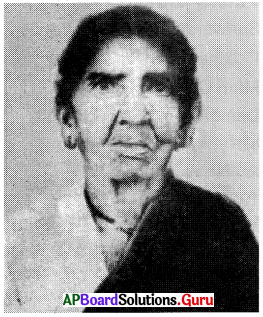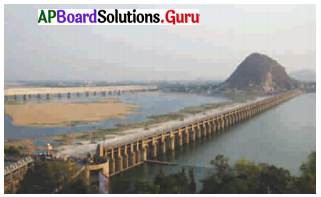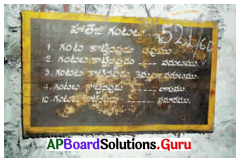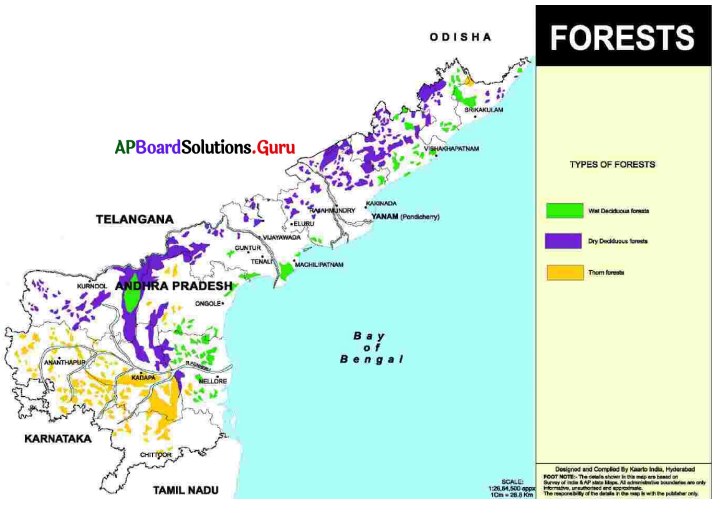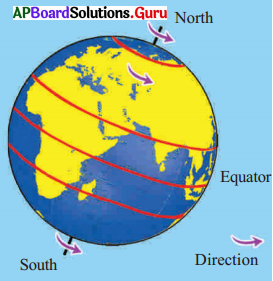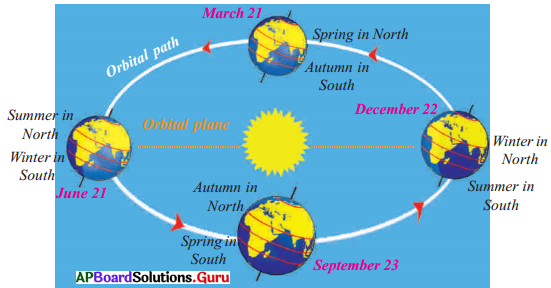Practice the AP 8th Class Social Bits with Answers Chapter 13 The Indian Constitution on a regular basis so that you can attempt exams with utmost confidence.
AP State Syllabus 8th Class Social Bits 13th Lesson The Indian Constitution with Answers
Choose the correct answer.
Question 1.
Our leaders who taught against British rule, wanted the future government of India to be
A) Democratic
B) Anarchical
C) Monarchy
D) None of the above
Answer:
A) Democratic
Question 2.
All the civilians have …………. rights.
A) Adult
B) Fundamental
C) Children
D) None of the above
Answer:
B) Fundamental
![]()
Question 3.
Motilal Nehru and eight other Indian National Congress leaders drafted a Constitution for India in ……….
A) 1948
B) 1949
C) 1928
D) 1938
Answer:
C) 1928
Question 4.
In 1931, the resolution at the session of the Indian National Congress dwelt on how independent India’s Constitution should look like.
A) Lahore
B) Lucknow
C) Jaipur
D) Karachi
Answer:
D) Karachi
Question 5.
The Socialist Revolution in Russia and had inspired many Indians to think of shaping a system based on social and economic equality.
A) China
B) France
C) Afghanisthan
D) Kajakisthan
Answer:
A) China
Question 6.
There were …………….. women members in our Constituent Assembly.
A) 14
B) 15
C) 16
D) 13
Answer:
B) 15
![]()
Question 7.
The first Prime Minister of India was
A) L.B. Sastry
B) Motilal Nehru
C) Jawaharlal Nehru
D) Gandhiji
Answer:
C) Jawaharlal Nehru
Question 8.
The members of the Constituent Assembly deliberated for …………. days.
A) 111
B) 142
C) 113
D) 114
Answer:
D) 114
Question 9.
The values that formed the foundation for India’s democracy are embedded in the …………… of the Indian Constitution.
A) Preamble
B) First part
C) Second part
D) Third Part
Answer:
A) Preamble
Question 10.
………….. is the head of the Government.
A) Prime Minister
B) President
C) Speaker
D) All the above
Answer:
B) President
![]()
Question 11.
The government ruled the people by the elected representatives.
A) Kulina rule
B) Democracy
C) Kingship
D) All the above
Answer:
B) Democracy
Question 12.
A …………. is a set of rules about how the country should be governed.
A) Constitution
B) Report
C) Summary
D) Complex, picture
Answer:
A) Constitution
Question 13.
This is mentioned in the Constitution.
A) How to make laws?
B) How to change laws?
C) How the government forms?
D) All the above
Answer:
D) All the above
Question 14.
The amendments that were done to the Indian Constitution till 2011.
A) 90
B) 95
C) 97
D) 100
Answer:
C) 97
![]()
Question 15.
The main objective of our national movement.
A) Fighting against foreign rule
B) Eradication of inequalities
C) Eradication of exploitation and discrimination in our society
D) All the above
Answer:
D) All the above
Question 16.
The Indian Constitution was drafted in 1928 before independence under the leadership of
A) Jawaharlal Nehru
B) Motilal Nehru
C) B.R. Ambedkar
D) Rajendra Prasad
Answer:
B) Motilal Nehru
Question 17.
In 1931, the resolution at the session of the INC dwelt on how independent India’s Constitution should look like.
A) Calcutta
B) Karachi
C) Bombay
D) Pune
Answer:
B) Karachi
Question 18.
The international incidents that inspired the Indian National leaders
A) Ideals of French Revolution
B) Britain Parliamentary democracy
C) American Rights Act
D) All the above
Answer:
D) All the above
![]()
Question 19.
Elections were held in …………….. to Provincial Legislatures and Ministries all over British India.
A) 1935
B) 1936
C) 1937
D) 1940
Answer:
C) 1937
Question 20.
Elections were held to the Constituent Assembly.
A) July, 1946
B) July 1947
C) August 1946
D) August, 1947
Answer:
A) July, 1946
Question 21.
The first meeting of the Constituent Assembly was conducted in
A) December, 1946
B) December, 1947
C) July, 1946
D) July, 1947
Answer:
A) December, 1946
Question 22.
The number of members in the Constituent Assembly.
A) 280
B) 299
C) 300
D) 305
Answer:
B) 299
![]()
Question 23.
The Indian Constitution adopted the Constitution on
A) 26-11 -1949
B) 26-09-1949
C) 26-10-1949
D) 26-01-1949
Answer:
A) 26-11 -1949
Question 24.
The Indian Constitution came into existence on
A) 26-11-1949
B) 26-01-1950
C) 15-8-1947
D) 26-11-1948
Answer:
B) 26-01-1950
Question 25.
The Republic day in India
A) 15th August
B) 9th January
C) 26th January
D) 1st November
Answer:
C) 26th January
Question 26.
The handwork of India for world peace and the welfare of human beings is called
A) Ideals resolution
B) Objectives resolution
C) Taking decisions
D) Summary of declarations
Answer:
B) Objectives resolution
![]()
Question 27.
Bringing changes in the contents of the Constitution is called
A) constitutional amendment
B) constitutional prerana
C) Peoples change
D) clear change
Answer:
A) constitutional amendment
Question 28.
The recording of each and every word that was spoken in the Constituent Assembly is called ………..
A) Constitutional Amendment
B) Constituent Assembly
C) Constituent Assembly Debates
D) Adoption of Constitution
Answer:
C) Constituent Assembly Debates
Question 29.
Mahatma Gandhi was not a member of the Constituent Assembly. But he wrote his vision about the constitution in his ……………. magazine in 1931.
A) Hanizan
B) Young India
C) Amrith Bazar Pathrika
D) Sanjeevani
Answer:
B) Young India
Question 30.
The dream of an India without inequality was shared by
A) Alladi Krishna Swamy Ayyangar
B) Dr. B.R. Ambedkar
C) D.P. Khaithan
D) Rajendra Prasad
Answer:
B) Dr. B.R. Ambedkar
![]()
Question 31.
“One man one vote and one vote one value” India follows this principle Who said these words?
A) Rajendra Prasad
B) Jawaharlal Nehru
C) Dr. B.R. Ambedkar
D) Sardar Vallabhai patel
Answer:
C) Dr. B.R. Ambedkar
Question 32.
The service of India means the service of the millions who suffer. These words are said by
A) Rajendra Prasad
B) Jawaharlal Nehru
C) Dr. B.R. Ambedkar
D) Dadabhai Naoroji
Answer:
B) Jawaharlal Nehru
Question 33.
“We the people of India, having resolved to constitute India into a Republic and to secure to all its citizen’s Justice, Liberty, Equality, and Fraternity give ourselves this Constitution,” was mentioned in the
A) Preamble
B) Democracy
C) Sovereignty
D) All the above
Answer:
A) Preamble
Question 34.
The state that has an elected head as its head
A) Democracy
B) Republic
C) Sovereign
D) Socialist
Answer:
B) Republic
![]()
Question 35.
India will have the supreme right to make decisions on internal as well as external matters and make her own laws.
A) Democracy
B) Republic
C) Sovereign
D) Socialism
Answer:
C) Sovereign
Question 36.
Which country tries to reduce and eradicate all kinds of inequalities?
A) Democracy
B) Republic
C) Sovereign
D) Socialist
Answer:
D) Socialist
Question 37.
Citizens will have complete freedom to follow any religion or no religion at all.
A) Socialism
B) Secularism
C) Democracy
D) Republic
Answer:
B) Secularism
Question 38.
In this type of government, all the people enjoy equal political rights
A) Socialism
B) Secularism
C) Democracy
D) Republic
Answer:
C) Democracy
![]()
Question 39.
All citizens should get what is their due in determining what is due to than no discrimination will be made on account of their birth, caste, tribe, community or beliefs, or wealth or status.
A) Justice
B) Equality
C) Secularism
D) Sovereignty
Answer:
A) Justice
Question 40.
All public offices shall be open to all, irrespective of caste or religion.
A) Justice
B) Equality
C) Secularism
D) Sovereignty
Answer:
B) Equality
Question 41.
There will be no unreasonable restrictions on the citizens in what way they think.
A) Justice
B) Equality
C) Liberty
D) Sovereignty
Answer:
C) Liberty
Question 42.
Our democracy
A) Parliamentary
B) Presidential
C) Both A & B
D) None
Answer:
A) Parliamentary
![]()
Question 43.
This issue does not relate to the state list
A) police
B) road transport
C) schools
D) army
Answer:
D) army
Question 44.
The members of Lok Sabha are elected by the
A) people
B) government
C) states
D) All the above
Answer:
A) people
Question 45.
The members of the Rajya Sabha are elected by the
A) people
B) government
C) state assemblies
D) members of Lok Sabha
Answer:
C) state assemblies
Question 46.
The tiers of Indian democracy
A) 1
B) 3
C) 4
D) 5
Answer:
B) 3
![]()
Question 47.
The non-political organization
A) Comptroller and Auditor General
B) Election Commission
C) Judicial System
D) Neeti Ayog
Answer:
D) Neeti Ayog
Question 48.
Choose the correct matching.
Group – A Group – B
1) 1946 July ( ) a) Constitution came into effect
2) 1947 August ( ) b) Adoption of Constituent Assembly
3) 1949 Nov, 26 ( ) c) Elections to the Constituent Assembly
4) 1950 Jan, 26 ( ) d) British India Elections
5) 1937 ( ) e) Division of Constituent Assembly
A) 1 – c, 2 – e, 3 – b, 4 – a, 5 – d
B) 1 – a, 2 – e, 3 – d, 4 – b, 5 – c
C) 1 – a, 2 – b, 3 – c, 4 – d, 5 – e
D) 1 – c, 2 – a, 3 – e, 4 – b, 5 – d
Answer:
A) 1 – c, 2 – e, 3 – b, 4 – a, 5 – d
Question 49.
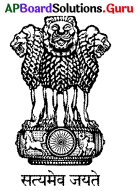
Pick the correct comment.
A) Satyameva Jayathe is a quote from an Upanishad.
B) The four Asiatic lions are symbolizing power, courage, confidence, and pride.
C) The wheel of law is also presented there.
D) All the above Everyone would be equal before the law.
Answer:
D) All the above Everyone would be equal before the law.
![]()
Question 50.
Pick the correct comment.
A) There are different punishments for like crimes.
B) All are equal before the law.
C) The elected persons have some privileges in this regard.
D) None
Answer:
B) All are equal before the law.
Question 51.
‘Elections to the Constituent Assembly were held in July 1946. Its first meeting was held in December 1946.’
What was the main change in this period?
A) Muslim League opposed it.
B) Many elected members resigned.
C) Partition of the country
D) All the above
Answer:
C) Partition of the country
Question 52.
“We the people of India, having resolved to constitute India into a Republic and to secure to all its citizen’s Justice, Liberty, Equality and Fraternity give ourselves this Constitution.”
Who gave us the Constitution?
A) The British
B) The leaders
C) Ourselves
D) All the above
Answer:
C) Ourselves
![]()
Question 53.
The main reason for the partition of the country
A) caste conflicts
B) regionalism
C) religious conflicts
D) All the above
Answer:
C) religious conflicts
Question 54.
The Constitution of India was drafted under very difficult circumstances. The difficulty was
A) The country was under British rule for many years.
B) Communal conflicts
C) Partition
D) All the above
Answer:
D) All the above
Question 55.
The Chairman of the Indian Drafting Committee
A) Rajendra Prasad
B) Dr. B.R. Ambedkar
C) Durgabai Deshmukh
D) Sarojini Naidu
Answer:
B) Dr. B.R. Ambedkar
![]()
Question 56.
During national movement people died because of
A) Poverty
B) Famine and Epidemics
C) Both A & B
D) All the above
Answer:
C) Both A & B
